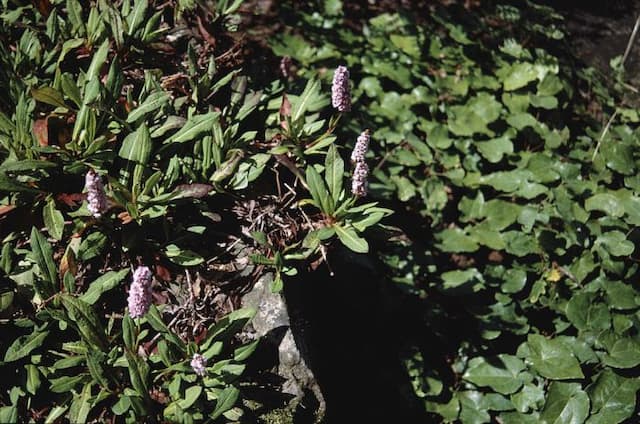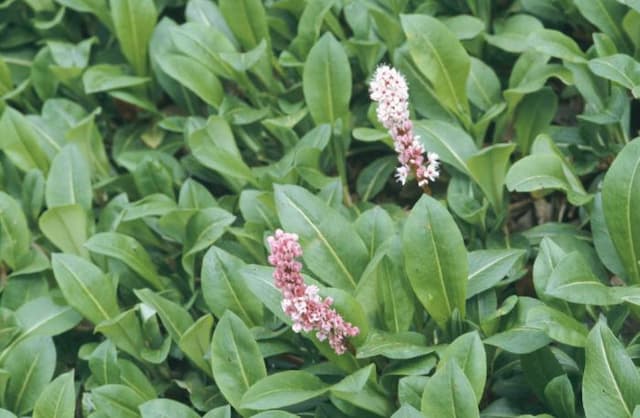Alpine knotweed Persicaria alpina

ABOUT
The alpine knotweed is a robust perennial plant that is quite conspicuous due to its broad, slightly heart-shaped leaves which have a somewhat coarse texture. The leaves are arranged alternately along the stems, providing a lush, dense look. They are typically dark green with a marked paler underside that contrasts with the vivid green above. During the blooming period, the alpine knotweed produces elongated clusters of tiny, white or pale pink flowers, giving off a frothy, featherlike appearance. These flowers are quite small when observed individually but when seen together in dense, tapering spikes, they create an impressive display. The stems of the alpine knotweed are strong and can be reddish or green, contributing to the plant's generally verdant and vigorous appearance. The overall impression one gets from the alpine knotweed is that of a hearty plant with a lush, leafy presence and delicate floral spikes that add a touch of lightness to its appearance.
About this plant
 Names
NamesFamily
Polygonaceae
Synonyms
Alpine Knotweed, Mountain Fleece, Mountain Fleeceflower
Common names
Polygonum alpinum, Aconogonon alpinum, Bistorta alpina, Persicaria alpina.
 Toxicity
ToxicityTo humans
Persicaria alpina, commonly known as Alpine knotweed, is not generally considered toxic to humans. There is limited information regarding its toxicity, and it is not commonly associated with poisoning or any severe health issues upon ingestion. However, as with many plants, individual allergies or sensitivities can vary, and it is always advisable to exercise caution and avoid eating plants that are not known to be safe for consumption.
To pets
Alpine knotweed, while not extensively reported as a common toxin, is not typically regarded as poisonous to pets either. There is a lack of specific documentation on its toxicity to animals, and it does not appear on major lists of toxic plants. Nonetheless, it is still wise to prevent pets from ingesting plants that are not confirmed to be safe, as individual reactions can occur and certain parts of the plant (e.g., roots, stems, leaves) might cause mild gastrointestinal upset if consumed in large quantities.
 Characteristics
CharacteristicsLife cycle
Perennials
Foliage type
Deciduous
Color of leaves
Green
Flower color
White
Height
4 feet (1.22 meters)
Spread
4 feet (1.22 meters)
Plant type
Herb
Hardiness zones
5
Native area
Europe
Benefits
 General Benefits
General Benefits- Landscape beautification: Persicaria alpina, commonly known as Alpine Knotweed, adds aesthetic value to gardens with its tall structure and attractive flower spikes.
- Erosion control: The robust root system of Alpine Knotweed helps in stabilizing soil, making it effective for controlling erosion on sloped areas.
- Wildlife habitat: Its flowers provide nectar for pollinators such as bees and butterflies, while its dense foliage can offer shelter for small wildlife.
- Low maintenance: Alpine Knotweed is known for being hardy and requiring minimal upkeep once established, making it suitable for low-maintenance landscaping.
- Tolerance of tough conditions: It can thrive in a variety of soil types and can handle both moist and dry conditions, which makes it adaptable to different environments.
- Seasonal interest: With flowers blooming in the summer and leaves that change color in autumn, Alpine Knotweed offers visual interest throughout multiple seasons.
- Quick growth: As a fast-growing plant, Alpine Knotweed can quickly fill in garden spaces, making it ideal for creating dense borders or groundcover.
 Medical Properties
Medical Properties- This plant is not used for medical purposes.
 Air-purifying Qualities
Air-purifying QualitiesThis plant is not specifically known for air purifying qualities.
 Other Uses
Other Uses- Dye production: Persicaria alpina, also known as Alpine bistort, can be used to create a natural dye for fabric, yielding shades of brown or green depending on the mordant used.
- Ornamental garden plant: Due to its attractive foliage and spikes of pink or white flowers, Alpine bistort is often planted in gardens for aesthetic appeal.
- Erosion control: Alpine bistort's dense growth habit and extensive root system make it excellent for stabilizing soil and preventing erosion in hilly or mountainous areas.
- Livestock forage: In some regions, Alpine bistort is used as a forage plant for animals, providing a source of nutrition, especially for sheep and cattle in high-altitude pastures.
- Biomass production: The plant can be cultivated for biomass, either for composting or as a potential biofuel source due to its rapid growth in suitable conditions.
- Floral arrangements: Fresh or dried spikes of Alpine bistort flowers can be used in floral arrangements for their unique, elongated shape and subtle beauty.
- Culinary uses: Young leaves and shoots of Alpine bistort are sometimes used in culinary applications, cooked similarly to spinach, predominantly in traditional mountainous region cuisines.
- Handicraft materials: The stems and leaves of Alpine bistort can be utilized in the crafting of small hand-made items, such as naturally woven baskets or eco-friendly decorative pieces.
- Photography and art: The striking appearance of Alpine bistort makes it a favorite subject for photographers and artists, who capture its form and color in various mediums.
- Soil improvement: Alpine bistort can contribute to soil health by adding organic matter as it decomposes, increasing soil fertility and structure.
Interesting Facts
 Feng Shui
Feng ShuiThe Persicaria alpina, commonly known as Alpine knotweed or Mountain fleece, is not used in Feng Shui practice.
 Zodiac Sign Compitability
Zodiac Sign CompitabilityThe Alpine knotweed is not used in astrology practice.
 Plant Symbolism
Plant Symbolism- Adaptability: Persicaria alpina, commonly known as Alpine Knotweed, thrives in various conditions, symbolizing the ability to adapt to different environments and situations.
- Resilience: The plant's robust nature and persistence in harsh alpine climates make it a symbol of resilience and strength in the face of adversity.
- Growth: Alpine Knotweed's vigorous growth habit can represent personal growth or the expansion of ideas and projects.
- Connection: The interconnected root system of Persicaria alpina symbolizes the idea of connection and interdependence among individuals or within communities.
 Water
WaterThe Alpine bistort should be watered regularly, maintaining a consistent moisture level without allowing the soil to become waterlogged. Ideally, watering should take place early in the morning or late in the afternoon to reduce evaporation. During the growing season, water approximately once a week, providing about 1 to 2 gallons per watering for a medium-sized plant, depending on the climate and soil drainage. In hot, dry periods, you may need to increase the frequency to twice a week, ensuring the soil stays evenly moist. Cut back on watering in the fall and water sparingly in winter, only when the soil is dry to the touch.
 Light
LightThe Alpine bistort thrives in partial shade to full sun conditions. It prefers a spot that receives morning sunlight and partial shade during the intense heat of the afternoon, which helps protect its foliage from scorching. A location that provides dappled sunlight throughout the day is ideal for this plant, ensuring a balance of light exposure and protection.
 Temperature
TemperatureAlpine bistort is hardy and can tolerate a range of temperatures, but it flourishes in conditions roughly between 60°F and 75°F. It can withstand cold down to about 20°F and can survive short periods of temperatures slightly higher than 75°F as long as it is not exposed to direct, scorching sun. The ideal temperature range provides a hospitable environment for continued growth and flowering.
 Pruning
PruningPruning the Alpine bistort is necessary to remove dead or damaged foliage and to encourage denser growth. Prune in late winter or early spring before new growth begins. Cutting back the spent flower stalks after blooming can promote a second bloom and maintain the plant's appearance. Pruning every year or every other year is generally sufficient to keep the plant healthy and well-shaped.
 Cleaning
CleaningAs needed
 Soil
SoilAlpine knotweed prefers moist, well-drained soil with a high organic content. A mixture of garden soil, compost, and peat moss can create an ideal growing medium. Aim for a soil pH ranging between 5.5 and 7 for optimal growth.
 Repotting
RepottingAlpine knotweed doesn't require frequent repotting; it can be repotted every 2-3 years or when it outgrows its current pot.
 Humidity & Misting
Humidity & MistingAlpine knotweed thrives in moderate to high humidity levels, typically between 60% and 80%.
 Suitable locations
Suitable locationsIndoor
Place in bright, indirect light with moist soil.
Outdoor
Choose a moist, shaded spot with rich soil.
Hardiness zone
4-7 USDA.
 Life cycle
Life cyclePersicaria alpina, commonly known as Alpine Knotweed, starts its life as a seed, germinating in favorable spring conditions with moist soil and adequate sunlight. Seedlings establish themselves, growing roots and leaves through the process of vegetative growth, gradually forming a dense clump of foliage. As the plant matures, it enters the reproductive phase, typically in the summer months, producing tall flowering stalks with clusters of small, white or pinkish flowers, which attract pollinators for sexual reproduction. After pollination and during late summer to early fall, flowers develop into fruits, each containing a single seed, which are then dispersed by various means such as water, wind, or animals. Following seed dispersal, the plant prepares for overwintering, with the above-ground parts dying back while the perennial root system survives the cold. In spring, the cycle restarts as new shoots emerge from the surviving roots, continuing the life cycle of the Alpine Knotweed.
 Propogation
PropogationPropogation time
Spring-Early Summer
Propogation: Persicaria alpina, commonly known as Alpine bistort, is typically propagated through division. The best time to do this is in early spring as the plants begin to emerge or in the autumn after the foliage has died back. To propagate through division, carefully dig up an established clump and separate it into smaller clumps. Ensure that each new section has at least one shoot and a portion of the root system attached. These divisions can then be replanted in well-prepared soil, at the same depth they were growing before. Water the new plants thoroughly to help establish them in their new location.
![Red bistort [JS Seven Oaks Village]](/_next/image?url=https%3A%2F%2Fplants-admin.emdemapps.com%2Fimages%2Fplants%2F%2Fimages%2F604b56557c0e3.png&w=640&q=75)








